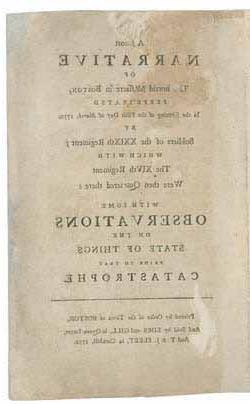Collections Online
A Short Narrative of the Horrid Massacre in Boston...
To order an image, navigate to the full
display and click "request this image"
on the blue toolbar.
-
Choose an alternate description of this item written for these projects:
- Coming of the American Revolution
- Boston Massacre
- Main description
[ This description is from the project: Witness to America's Past ]
After the events of early March 1770, the town of Boston appointed a committee consisting of James Bowdoin, Joseph Warren, and Samuel Pemberton to investigate the "horrid Massacre." The committee report along with ninety-six depositions from witnesses was rushed into print and dispatched to England, to lay out the colonists' side of the story. (Footnote 1) Copies in Boston were supposed to be suppressed until after the trials of the soldiers, to avoid influencing the juries, but were circulated before the trials began. (Footnote 2) At the same time that the affidavits in this volume were being collected, depositions showing the soldiers in good light were being gathered and sent to England. These were published in London as A fair account of the late unhappy disturbance at Boston in New England....
Shown here is the deposition of Dr. Benjamin Church on the autopsy on Crispus Attucks, "who was supposed to be murdered by the soldiers on Monday evening the 5th." Attucks, who went by the name Michael Johnson at the time of the massacre, was discovered after his death to be Crispus Attucks of Framingham, a "mollatto" who apparently escaped from slavery in 1750. According to local lore he was part African and part Native American of the Natick tribe. Regarded today as America's first black hero, Attucks led a group of sailors to the site of the riot but there was shot and thus became one of the first victims of the American Revolution. (Footnote 3) Ironically, Dr. Church, who performed the autopsy, was later court-martialed for treasonously corresponding with the enemy in coded messages.
At the subsequent trials, the British Captain Thomas Preston and six of his men were acquitted of murder, while two soldiers were convicted of manslaughter, branded on the thumb, and released. The soldiers' defense was offered by John Adams and Josiah Quincy, Jr., while the prosecuting attorneys were Robert Treat Paine and Samuel Quincy. This copy of the Short Narrative belonged to Robert Treat Paine (1730/1-1814) and contains his notes on the grand jury depositions. Although a native of Boston, Paine was at this time living and practicing law at Taunton, Massachusetts. In 1774 he became a member of the Massachusetts delegation to the First Continental Congress in Philadelphia, where he served as chairman of the important munitions committee, but he is best remembered as a signer of the Declaration of Independence in 1776. In 1777 Paine returned to Boston, where he was elected the state's first attorney general, a position he kept until 1790 when he was appointed an associate justice of the Massachusetts Supreme Court. (Footnote 4)
The papers of Adams, Paine, and the Quincy family are at the Historical Society and contain extensive information on the trials as well as on the Revolution that would follow. (Footnote 5)
Footnotes
5. Adams, Thomas Randolph. American Independence: The Growth of an Idea. Providence, R.I.: Brown University Press,1965, p. 57.
6. Zobel, Hiller B. The Boston Massacre. New YorK: W. W. Norton,1970, p. 213
7. Kaplan, Sideny. The Black Presence in the Era of the American Revolution, 1770-1800. [Greenwich, Conn.] : New York Graphic Society, 1973, pp. 7-8.
8. Sibley, John Langdon and Clifford K. Shipton. Biographical Sketches of Graduates of Harvard University. 17 vols. Cambridge, Mass.: Charles William Sever, 1873, 12:462-482.
9. Legal Papers of John Adams. Eds. L. Kinvin Wroth and Hiller B. Zobel. 3 vols. Cambridge, Mass.: Belknap Press of Harvard University Press,1965, 3:35.

